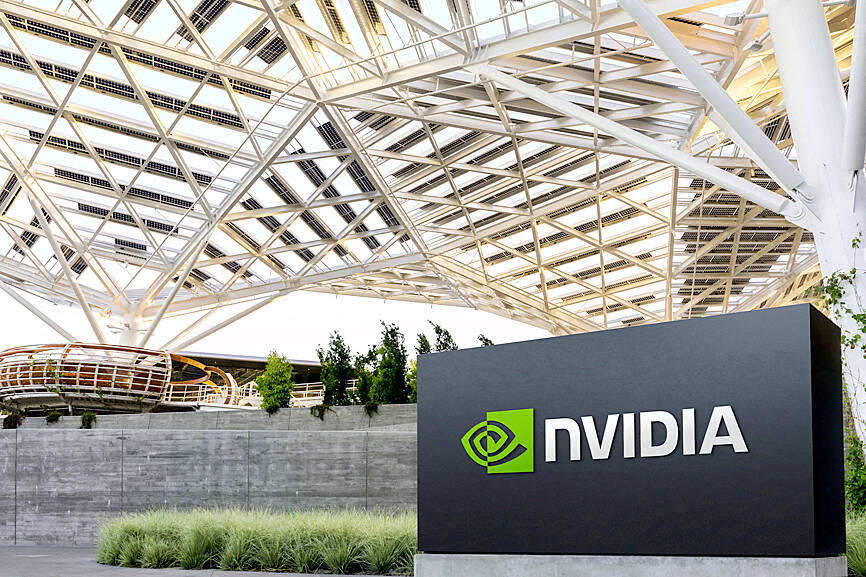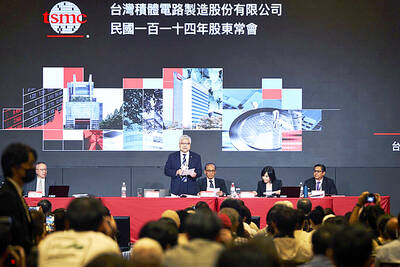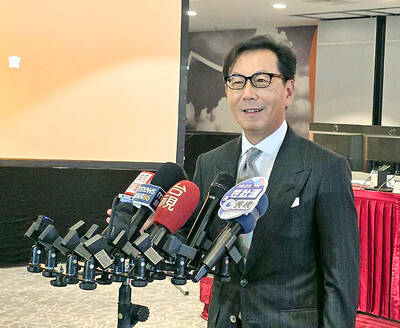Nvidia Corp earned its US$2.2 trillion market cap by producing artificial intelligence (AI) chips that have become the lifeblood powering the new era of generative AI developers from start-ups to Microsoft Corp, OpenAI and Google parent Alphabet Inc.
Almost as important to its hardware is the company’s nearly 20 years’ worth of computer code, which helps make competition with the company nearly impossible. More than 4 million global developers rely on Nvidia’s CUDA software platform to build AI and other apps.
Now a coalition of tech companies that includes Qualcomm Inc, Google and Intel Corp plans to loosen Nvidia’s chokehold by going after the chip giant’s secret weapon: the software that keeps developers tied to Nvidia chips. They are part of an expanding group of financiers and companies hacking away at Nvidia’s dominance in AI.

Photo: Reuters / Nvidia
“We’re actually showing developers how you migrate out from an Nvidia platform,” Qualcomm head of AI and machine learning Vinesh Sukumar said in an interview.
Starting with a piece of technology developed by Intel called OneAPI, the UXL Foundation — a consortium of tech companies — plans to build a suite of software and tools that would be able to power multiple types of AI accelerator chips, executives involved with the group said.
The open-source project aims to make computer code run on any machine, regardless of what chip and hardware powers it.
“It’s about specifically — in the context of machine learning frameworks — how do we create an open ecosystem, and promote productivity and choice in hardware,” Google director and chief technologist of high-performance computing Bill Magro said in an interview.
Google is one of the founding members of UXL and helps determine the technical direction of the project, Magro said.
UXL’s technical steering committee is preparing to nail down technical specifications in the first half of this year. Engineers plan to refine the technical details to a “mature” state by the end of the year, executives said.
These executives stressed the need to build a solid foundation to include contributions from multiple companies that can also be deployed on any chip or hardware.
Beyond the initial companies involved, UXL will court cloud-computing companies such as Amazon.com Inc and Microsoft’s Azure, as well as additional chipmakers.
Since its launch in September last year, UXL has begun to receive technical contributions from third parties that include foundation members and outsiders keen on using the open-source technology, executives said.
Intel’s OneAPI is already usable, and the second step is to create a standard programming model of computing designed for AI.
UXL plans to put its resources toward addressing the most pressing computing problems dominated by a few chipmakers, such as the latest AI apps and high-performance computing applications. Those early plans feed into the organization’s longer-term goal of winning over a critical mass of developers to its platform. UXL eventually aims to support Nvidia hardware and code in the long run.
Asked about the open source and venture-funded software efforts to break Nvidia’s AI dominance, Nvidia executive Ian Buck said in a statement: “The world is getting accelerated. New ideas in accelerated computing are coming from all across the ecosystem, and that will help advance AI and the scope of what accelerated computing can achieve.”

CAUTIOUS RECOVERY: While the manufacturing sector returned to growth amid the US-China trade truce, firms remain wary as uncertainty clouds the outlook, the CIER said The local manufacturing sector returned to expansion last month, as the official purchasing managers’ index (PMI) rose 2.1 points to 51.0, driven by a temporary easing in US-China trade tensions, the Chung-Hua Institution for Economic Research (CIER, 中華經濟研究院) said yesterday. The PMI gauges the health of the manufacturing industry, with readings above 50 indicating expansion and those below 50 signaling contraction. “Firms are not as pessimistic as they were in April, but they remain far from optimistic,” CIER president Lien Hsien-ming (連賢明) said at a news conference. The full impact of US tariff decisions is unlikely to become clear until later this month

GROWING CONCERN: Some senior Trump administration officials opposed the UAE expansion over fears that another TSMC project could jeopardize its US investment Taiwan Semiconductor Manufacturing Co (TSMC, 台積電) is evaluating building an advanced production facility in the United Arab Emirates (UAE) and has discussed the possibility with officials in US President Donald Trump’s administration, people familiar with the matter said, in a potentially major bet on the Middle East that would only come to fruition with Washington’s approval. The company has had multiple meetings in the past few months with US Special Envoy to the Middle East Steve Witkoff and officials from MGX, an influential investment vehicle overseen by the UAE president’s brother, the people said. The conversations are a continuation of talks that

CHIP DUTIES: TSMC said it voiced its concerns to Washington about tariffs, telling the US commerce department that it wants ‘fair treatment’ to protect its competitiveness Taiwan Semiconductor Manufacturing Co (TSMC, 台積電) yesterday reiterated robust business prospects for this year as strong artificial intelligence (AI) chip demand from Nvidia Corp and other customers would absorb the impacts of US tariffs. “The impact of tariffs would be indirect, as the custom tax is the importers’ responsibility, not the exporters,” TSMC chairman and chief executive officer C.C. Wei (魏哲家) said at the chipmaker’s annual shareholders’ meeting in Hsinchu City. TSMC’s business could be affected if people become reluctant to buy electronics due to inflated prices, Wei said. In addition, the chipmaker has voiced its concern to the US Department of Commerce

STILL LOADED: Last year’s richest person, Quanta Computer Inc chairman Barry Lam, dropped to second place despite an 8 percent increase in his wealth to US$12.6 billion Staff writer, with CNA Daniel Tsai (蔡明忠) and Richard Tsai (蔡明興), the brothers who run Fubon Group (富邦集團), topped the Forbes list of Taiwan’s 50 richest people this year, released on Wednesday in New York. The magazine said that a stronger New Taiwan dollar pushed the combined wealth of Taiwan’s 50 richest people up 13 percent, from US$174 billion to US$197 billion, with 36 of the people on the list seeing their wealth increase. That came as Taiwan’s economy grew 4.6 percent last year, its fastest pace in three years, driven by the strong performance of the semiconductor industry, the magazine said. The Tsai